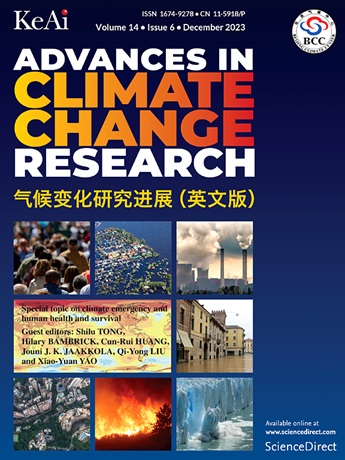Projection of sea ice conditions in the Canadian Arctic Archipelago based on CMIP6 assessments
IF 5.2
1区 地球科学
Q1 ENVIRONMENTAL SCIENCES
引用次数: 0
Abstract
The Canadian Arctic Archipelago (CAA) includes the critical region of the Northwest Passage (NWP) and is one of the areas with the most severe sea ice conditions in the Arctic. Currently, studies on sea ice projections focusing on the CAA are limited. Furthermore, the prediction results for the CAA from different models based on the Coupled Model Intercomparison Project Phase 6 (CMIP6) exhibit uncertainty due to the inter-model spread. This study evaluated the projected data for sea ice concentration (SIC) and thickness (SIT) within the CAA from 14 CMIP6 models for the period 2015–2022 under the SSP2-4.5 scenario based on the satellite and reanalysis data. Although most models can capture the major characteristics of spatiotemporal variations in SIC and SIT within the CAA, there are considerable numerical differences compared to observations and reanalysis. Additionally, there is a notable spread among 14 CMIP6 models. The assessment of SIC indicates that CESM2, GFDL-CM4, IPSL-CM6A-LR, and UKESM1-0-LL exhibit better performance, with a relatively low bias (less than 7%), a root mean square error (RMSE) below 22%, and a relatively high correlation coefficient (CC) exceeding 0.75. In the evaluation of SIT, the four best-performing models are GFDL-CM4, MPI-ESM1-2-HR, MPI-ESM1-2-LR, and MRI-ESM2-0. The multi-model ensemble of the best performance group (MMMBPG) projects a declining trend in both sea ice area (SIA) and SIT for the CAA from 2025 to 2100, with respective trends of −0.21 × 105 km2 per decade and −0.06 m per decade under the SSP2-4.5 scenario, and −0.56 × 105 km2 per decade and −0.11 m per decade under the SSP5-8.5 scenario. Under both scenarios, the MMMBPG predicts a more notable reduction of sea ice in the NWP compared to the multi-model ensemble of all 14 models. Navigable conditions for the northern and southern routes are defined by SIA and SIT respectively, with each route's SIA being less than 5% of its total area and the mean SIT being below 0.15 m. Based on the SIA threshold, under the SSP2-4.5 and SSP5-8.5 scenarios, MMMBPG projects that continuous annual navigability in the NWP, with at least three navigable months per year, will be achieved starting in 2060 and 2054, respectively. According to the SIT threshold, the MMMBPG projects that it will reach continuous annual navigability with at least one navigable month per year under both scenarios, starting in 2038 and 2036, respectively. This study enhances the understanding of CMIP6 model performance in projecting sea ice within the CAA and provides insights into future sea ice conditions in the region.
基于CMIP6评估的加拿大北极群岛海冰状况预估
加拿大北极群岛(CAA)包括西北航道(NWP)的关键区域,是北极海冰状况最严重的地区之一。目前,针对CAA的海冰预估研究有限。此外,基于耦合模式比对项目第6阶段(CMIP6)的不同模式对CAA的预测结果由于模式间的差异而存在不确定性。本研究基于卫星和再分析数据,评估了2015-2022年SSP2-4.5情景下14个CMIP6模式的CAA内海冰浓度(SIC)和厚度(SIT)预估数据。虽然大多数模式可以捕捉到中国大陆地区SIC和SIT时空变化的主要特征,但与观测和再分析相比,存在相当大的数值差异。此外,在14个CMIP6模型中存在显著的分布。SIC评估表明,CESM2、GFDL-CM4、IPSL-CM6A-LR和UKESM1-0-LL表现出较好的性能,偏差相对较低(小于7%),均方根误差(RMSE)小于22%,相关系数(CC)大于0.75。在SIT的评估中,表现最好的四种模型是GFDL-CM4、MPI-ESM1-2-HR、MPI-ESM1-2-LR和MRI-ESM2-0。最佳表现组(MMMBPG)的多模式集合预测了2025 - 2100年CAA海冰面积(SIA)和SIT的下降趋势,在SSP2-4.5情景下分别为- 0.21 × 105 km2 / 10年和- 0.06 m / 10年,在SSP5-8.5情景下分别为- 0.56 × 105 km2 / 10年和- 0.11 m / 10年。在这两种情况下,与所有14种模式的多模式集合相比,MMMBPG预测NWP的海冰减少更为显著。北航和南航的通航条件分别由SIA和SIT确定,每条航线的SIA小于其总面积的5%,平均SIT小于0.15 m。基于SIA阈值,在SSP2-4.5和SSP5-8.5情景下,MMMBPG项目将分别从2060年和2054年开始实现NWP的连续年通航,每年至少有三个通航月。根据SIT阈值,MMMBPG项目将在2038年和2036年分别从两种情况下分别达到每年至少一个通航月的连续年度通航。该研究增强了对CMIP6模式在预测CAA海冰方面的性能的理解,并为该地区未来的海冰状况提供了见解。
本文章由计算机程序翻译,如有差异,请以英文原文为准。
求助全文
约1分钟内获得全文
求助全文
来源期刊

Advances in Climate Change Research
Earth and Planetary Sciences-Atmospheric Science
CiteScore
9.80
自引率
4.10%
发文量
424
审稿时长
107 days
期刊介绍:
Advances in Climate Change Research publishes scientific research and analyses on climate change and the interactions of climate change with society. This journal encompasses basic science and economic, social, and policy research, including studies on mitigation and adaptation to climate change.
Advances in Climate Change Research attempts to promote research in climate change and provide an impetus for the application of research achievements in numerous aspects, such as socioeconomic sustainable development, responses to the adaptation and mitigation of climate change, diplomatic negotiations of climate and environment policies, and the protection and exploitation of natural resources.
 求助内容:
求助内容: 应助结果提醒方式:
应助结果提醒方式:


